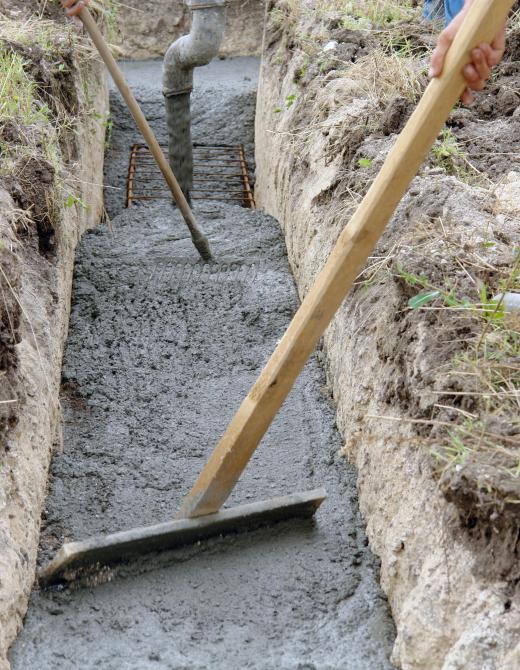When laying cement or concrete, a builder sometimes cannot lay the entire slab all at once. Weather, time constraints, or lack of materials might stop the project midway. When this happens, the builder needs to leave an even stopping place, called a construction joint. This joint is basically a straight line in the concrete. If done correctly, a construction joint can double as a contraction joint, a joint placed in the concrete to prevent cracking of the slab.
The edge of a construction joint is created using a bulkhead. Bulkheads can be made of various materials, from plastic to steel to preformed concrete. During the pouring and leveling process, bulkheads can double as screed rails. Concrete is poured between screed rails, the tops of which are then used as a guide when leveling the concrete. Normally, bulkheads and screed rails are removed after the slab is complete.

The design of a construction joint depends on the load the concrete is expected to bear. For foot traffic or small vehicle traffic, a simple butt joint is easiest. A butt joint consists of two slabs of concrete laid a few millimeters apart and delineated by bulkheads. If heavy vehicle traffic is expected, the construction joint should be reinforced with a load transfer device.
Load transfer devices prevent the cement slabs from shifting under heavy loads. Shifting can cause uneven slabs and breakdown in the joints. Dowels, load plates, or slots can be embedded into the concrete to act as load transfer devices. These devices are laid perpendicular to the construction joint, extending into both slabs across the joint. Their purpose is to distribute the load evenly between slabs.
In many cases, construction joints can double as contraction joints. As cement dries, it shrinks, which results in cracking. Though cracking is almost impossible to prevent, it can be controlled. Uncontrolled cracking can cause an uneven surface, which is subject to increased wear over time and water seepage, which can damage the substrate. Contraction joints are inserted into slabs to guide cracks along a predetermined line.
Contraction joints can be formed by cutting a groove in the slab or by embedding plastic strips into the slab. The purpose of the joint is to weaken the slab along the approved line so that the slab cracks there instead of somewhere else. In order to be effective, the contraction joint must be at least one quarter as deep as the slab is thick.
